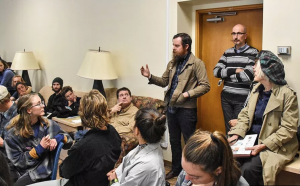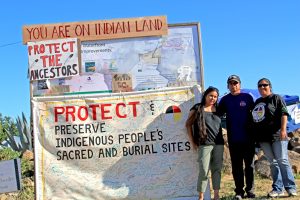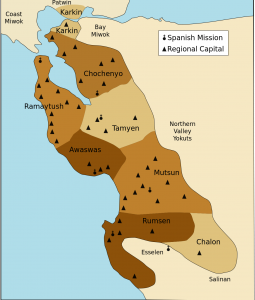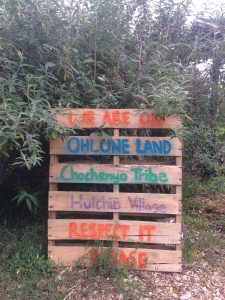In order for our democratic student association to value systematic inclusion and equitable distribution of land and its use of fruit, SOGA recognizes the need for indigenous land acknowledgment where it is due.
Located on Walnut St. & Virginia St., SOGA and Oxford Tract remains on top of sacred lands of Ohlone peoples (also known as Costanoan peoples), representing California’s indigenous peoples native to their ancestral homelands of the East Bay and Monterey Bay. Two centuries of genocide and colonization brought the desecration of Ohlone peoples lands and their cultures, and their survival heritage is yet to be established by Bay area city officials or California representatives (Miliken, et al., 2009). The militarization of murder, slavery, and forced assimilation caused by Spanish colonists and white American settlers was in order to steal Californian Native Americans’ sacred sites and extract their natural and cultural resources, and these concerted actions pushed for the elimination of Ohlone history, present identities, and future generations (BondGraham, 2017). While genocidal and colonialist agendas are still being honored by Bay-area public spaces and schooling systems, including UC Berkeley, the Ohlone peoples’ have been fighting for indigenous representation and reparations to be instated into California and US governments since the 20th century (Bean, 1994).
To this day, U.S. Government doesn’t consider the Ohlone peoples as a federally recognized American Indian tribe, despite large anthropological, historical, and cultural evidence of contemporary Ohlone peoples still existing in larger numbers than other tribal states. With “no reservations or protected land bases, and no rights, benefits, compensations or protections afforded to Indian tribes under US laws being received”, thousands of Ohlone people in the Bay-area are being disenfranchised by Bureau of Indian Affairs to this day since they’re active petitioning since 1988 (Sogorea Te Land Trust, 2019). Federal recognition by the BIA is hereby used as a modern strategy to exterminate tribes, where a disproportionately exhaustive and expensive “Federal Acknowledgement Process” creates an incongruous platform of legitimacy that would only further tribal oppression and competition that comes with centralized political organizations.
With this blatant extinguishing of Ohlone tribes, the Ohlone Womxn’s Group, in partnership with the Indian People Organizing for Change, has taken it upon themselves to continue their ancestral activism by advocating for the protection and care of their native lands, as well as revitalizing their cultural practices. The lack of federal recognition has also made pathways for growing shelter colonization and profit-motivated development on sacred Ohlone sites, where significant Bay-area cities have developed over their ancestral village, cultural, and burial sites, and continue to do so even to this day. Located on 1900 Fourth Street, the West Berkeley Shellmound is an on-going indigenous resistance effort led by the Ohlone peoples to protect the sacred grounds (ancestral burial sites) and village sites beneath the cement of West Berkeley. Although current development plans have been dropped by the city of Berkeley, the West Berkeley Shellmound continues to face land development pressures and the protection of these heritage sites has been one of the biggest fights for the Ohlone vision. As this site remains to be one of the largest shell mounds in Ohlone history, the vision of an open memorial site is currently being funded for an inter-subjective, multi-cultural gathering public space for West Berkeley (Gould, 2018).
Earlier this April, Chancellor Carol Christ of UCB affirmed that UC Berkeley’s Housing Master Plan for “affordable housing” will bring the demolition and loss of SOGA and Oxford Tract, two public garden spaces for environmental justice (Havens, 2019). Not only will the development of SOGA and Oxford Tract ruin the only alliance UCB officially has with the Ohlone peoples that acknowledges colonialism, but it will also degrade the spatial and temporal diversity of Ohlone lands that have been crucial to preserving the functionality of the agro-ecological research, food justice, and indigenous coalition-building conducted in those spaces (2019). This will also perpetuate UCB’s colonial history of unrecognition and blatant erasing of Califonia’s indigenous peoples and their cultures, as the entire university continues to build and further develop on the sacred lands of Ohlone peoples, stealing and profiting off the genocide, slavery, and extermination of tribal communities that still largely exist today.

Sogorea Te Land Trust, Oxford Tract, and SOGA members protesting against Chancellor Christ’s housing development plans.
The need to return ancestral lands back into the hands of indigenous land stewardship is evident throughout the Bay-area and the Sogorea Te Land Trust was created to address this restorative vision to bring back urban indigenous stewardship to the Ohlone Womxn’s Group in the 21st century. American history has inflicted many environmental injustices upon the Ohlone peoples and it is time to build up the resilience Ohlone peoples have continued to restore and revitalize within their own EJM. We aim to integrate the Ohlone peoples and SOGA’s internal alliances between native survival and environmental protection through land acknowledgment and allowing more native rights and leadership within our student environmental association. Our recognition of tribal value systems on the current crisis of nature as a crisis of society is valuable in SOGA’s reconstruction, as we aim to focus on our internal conflicts of disorganization as our prime problem, not the productivity of the garden (Moore, 1998).

Morning Star Gali, Wounded Knee DeOcampo & Corrina Gould (lead organizer of the Ohlone Womxn’s Group)
To read more information about Sogorea Te Land Trust and how to help their indigenous land stewardship, please visit their website or pay your Shuumi Tax today.
For more information about saving the West Berkeley Shellmound or donations to the alternative healing site, please visit their website.


